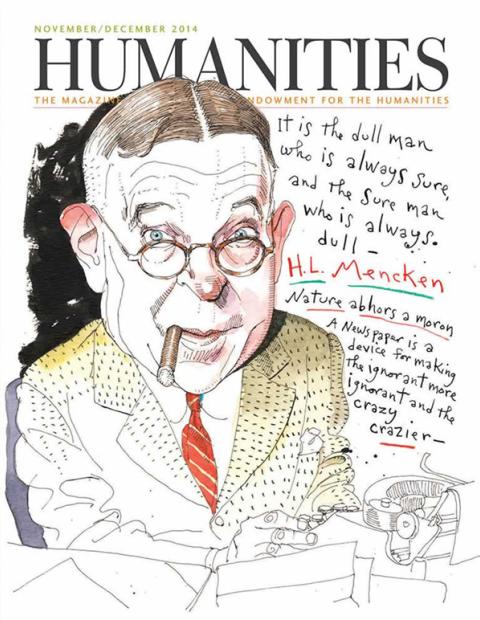A smile, a handshake, and an appreciation for the programs that Humanities Nebraska shares with the community define success, says Chris Sommerich, executive director of Humanities Nebraska. It is the moment of seeing people connect with what is happening with Humanities Nebraska and knowing that its programs matter.
Prime Time Family Reading Time, a reading and discussion program that has more than doubled in size in the last several years, “is a good example of what is clearly making a difference,” says Sommerich. “About six thousand children and parents have participated in the past ten years. It is one of the best examples for donors of how their support truly makes our communities better places.”
Sommerich joined Humanities Nebraska as its development officer in 2004 and became development director in 2007. Four years later, he was named executive director, following Jane Renner Hood, who had served for twenty-three years. “I stepped into this role after someone who has been a real icon,” says Sommerich. “It’s been interesting to do that.”
The council’s accomplishments, which include Chautauqua programming and a speakers bureau, can be attributed to staff, board volunteers, and a statewide network of partners that includes hundreds of different organizations each year. “We are seen as a valued and respected partner,” says Sommerich. “Collaboration is the most effective way to make a difference in a state like Nebraska.”
Sommerich, who holds bachelor’s and master’s degrees in political science from the University of Nebraska–Lincoln, is a Certified Fund Raising Executive and serves on the board of Community CROPS, a community-supported agriculture program. His experience before Humanities Nebraska includes being an undergraduate adviser and teaching assistant in the political science department at UNL and a development associate at Audubon Nebraska, work that Sommerich thinks prepared him for his current role as executive director, a position where he wears many hats.
Having a great staff is “the only way I can function,” says Sommerich. “To me, that’s really important. It’s what makes us strong. I think the only way to have a successful program is by surrounding yourself with people who are passionate about their jobs—have real ownership in it, are skilled at it, and are really good working as a team. That’s the key to doing a good job. And it’s not just the staff, but the board.”
As with any nonprofit, financials are also a big part of running an organization. Although the nation has had economic challenges, Sommerich says that Humanities Nebraska has been “really blessed by strong support from donors,” the state council’s second biggest source of funding, “and fortunate that no programs have been cut due to financial resources.”
“Donors have stuck with us, and they are loyal and see the value,” says Sommerich. “That has been very helpful. All nonprofits feel a little helpless when the economic winds blow one way, and we go through the hard times, and there are lot of needs out there and only so much to go around.”
To secure that long-term financial stability, Sommerich envisions building on existing funding sources, private donations, foundations, businesses and other entities, and endowment funding though a Nebraska Cultural Endowment the council shares with the Nebraska Arts Council.
“The point is to diversify our funding so we can continue to grow and meet more and more needs in the state without having to cut back or put a hold on things because of what happens in Washington,” says Sommerich.
Reaching beyond the regular audiences who attend museums, libraries, and university functions for humanities-type activities has also been a challenge, says Sommerich. “We have worked really hard to go beyond our past boundaries, our comfort zone, and having programs at museums and other traditional sites that people are used to going, and [we are] really stepping out at unique places with new program formats to reach more people.”
Some of those nontraditional places include coffeehouses, restaurants, and bars, where Humanities Nebraska takes what it normally does and adapts programs to fit into new environments. Recently in Norfolk, unsuspecting customers at a local bar met Chautauquans portraying Calamity Jane, Amelia Earhart, Mark Twain, Franklin D. Roosevelt, and other historical figures in character and costume.
“At first,” says Sommerich, “some of the bar crowd kept on talking amongst themselves, but our Gertrude Stein, who started things off, quickly and playfully chastised them into paying attention. From that point on, they just loved it. Many of them had no idea when they walked in that night that they would be treated to such an entertaining and educational spectacle.”
In a packed Omaha pub, two history professors led a discussion on Thomas Jefferson and the other Founding Fathers. A similar conversation program happened in a Mexican restaurant in South Omaha, where patrons debated whether native mascots are appropriate for professional sports teams, a conversation that coincides with “Hometown Teams,” a Smithsonian exhibit touring Nebraska this year.
“We need to reach more people and have to adapt to . . . truly reach all Nebraskans,” says Sommerich. “We need to move beyond our traditional program locations and take it to the streets, so to speak. That takes a lot of work at times, but the results are worth it.”

